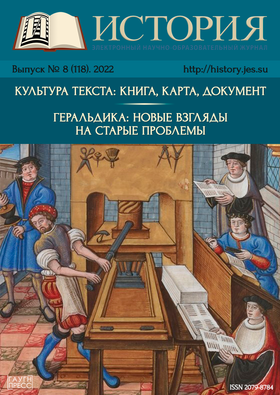
Share
Part I. Text Culture: Book, Map, Document (ed. by Elena Kazbekova, Irina Konovalova)
Text is a complex, structured form of information transfer, one of the key phenomena of human civilization, is in the center of attention of various humanities and natural sciences. The purpose of the issue is to analyze both the types of written texts and their artifacts (handwritten and printed books, maps, charters, letters, documents) that have become unique cultural patterns in various civilizations of the West and East in the Middle Ages and Modern times.
In the articles of researchers from Moscow, Saint Petersburg, Tver, leading specialists and young graduate students, new archival materials are introduced into scientific circulation, new interpretations of already known monuments are analyzed and proposed.
Using the methods of special and auxiliary historical disciplines (source study, paleography, codicology, diplomacy, historical geography, geoinformatics), the features of the creation and functioning of texts in the system of public administration and law in the West and East of Europe are studied with access to the problems of the history of church and secular chancelleries and government departments, notaries, universities, city associations, problems of land use and land tenure.
The articles in this issue explore current problems in the study of historical writing in Western Europe and Muscovite Russia; much attention is paid to the problems of source studies and the disclosure of the prosopographic potential of narrative texts. Issues of the material history of handwritten and printed books, which are significant for Cyrillic paleography, codicology, book science, are touched upon. The complex and sometimes ambiguous ways of conjugation of text and visual image in Europe of the late Middle Ages and early modern times are studied. A place is given to philological and source studies of hagiographic and theological literature, traditional for Western and Eastern Christian culture.
Separate sections in the issue are devoted to the analysis of historical-geographical and geo-informational issues in different types of written texts and related visual monuments, as well as to the study of the interaction of foreign written cultures, the creation and functioning of translations, the social aspects of the activities of professional translators and intellectual translators in a foreign language environment.
Part II. Heraldry: New Approach to Old Issues (ed. by Alexander Tchernik)
The following issue is dedicated to visual representation being a sociocultural component of historical processes. It starts with emblems from ancient coins, that served as state symbols of Greek polises and leads the reader through the timeline of evolution of European sign systems. Thus, coats of arms, occupying the central position of medieval visual space, were later displaced by other signs such as badges, banners, state emblem, etc. As divers as the signs themselves are the sources presenting them. They are numismatic, sigillographic, vexillological and narrative.
